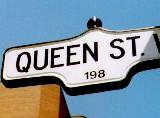
QUEEN STREET
Introduction
Life on the street
Thoughts on a ten-mile tour
(and a few of my tour guides)
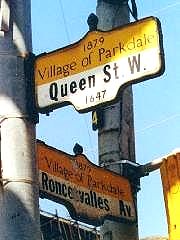
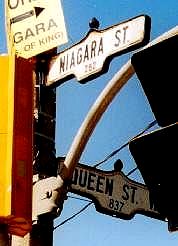
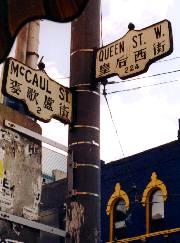
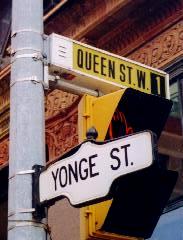
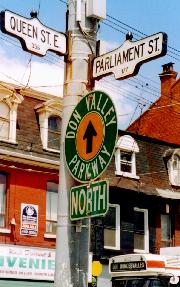
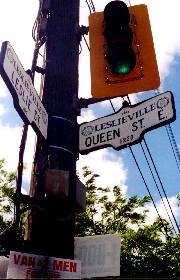
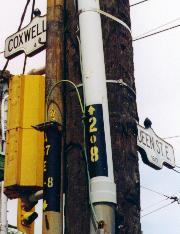
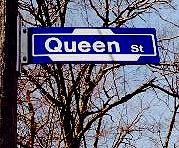
|
Signs of the Street
West to east: from the former Village of Parkdale to the former City of Scarborough; since 1889 & 1998 (respectively; it not always respectfully) encompassed by the City of Toronto. |
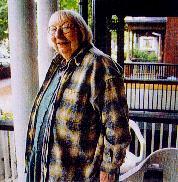
JANE JACOBS

IDEAS THAT MATTER
In New York, Toronto,
& cities everywhere
-
"Think of the city and what comes to mind? Its streets."
-- Jane Jacobs: The Death and Life of Great American Cities, 1961
Cities are many thing, to many people. Piles of glass, concrete, steel, acres of asphalt; hubs of energy and enterprise; masses of humanity, creativity, commerce -- even massive excess. To some they seem folly: recklessly crowded, madly rapacious; a cancer on the land. To others, cities are the cradle of civilization -- the very word going back to the Latin civitas (city), itself derived from civis, meaning "citizen."
To many of us cities are home, we their citizens. As I am. Even as I'm mindful of our burden on the planet, urban citizens often forgetful of the land on which we stand, I stand with New York poet Frank O'Hara in his love of city life:
- "...I have never clogged myself with the praises of pastoral life, nor with nostalgia for an innocent past of perverted acts in pastures. No. One need never leave the confines of New York to get all the greenery one wishes -- I can't even enjoy a blade of grass unless I know there's a subway handy, or a record store or some other sign that people do not totally regret life."
That last line is carved, in memory of Frank's feelings and of him, on a wall at New York's Battery Park. He died in 1966, hit by a dune buggy on Fire Island less than a month past his 40th birthday. It's from a poem he wrote in 1954: "Meditations in an Emergency."
What you'll find here grew of meditations, if not in what, from day to day, might seem an emergency. But it could soon be one: these are hard times for the life of my city, my home for the last 33 years. I came as an immigrant at the age of 19; within months I knew I'd found the right town.
Over those years I have seen it transformed: from dour Anglo "Toronto the Good" (so it was said) to "People City," "The City That Works" (or as Peter Ustinov put it, "New York run by the Swiss"); from hopes to preserve its distinct sense of "Time and Place" (as an early '70s activist group called itself) to cravings for status as "World Class." From People City -- to Megacity.
Here I look at it again: to see what I knew -- yet didn't always or everywhere know well. As Jane Jacobs said in her 1961 book The Death and Life of Great American Cities, casting new light on cities everywhere, what came to mind was its streets.
One street in particular.
Queen Street is one of Toronto's oldest, longest, and most varied routes. It began in 1793 as a line on a map, running dead straight for ten miles, in modern measure some 16 kilometres. It is the spine, the high street, the main street of many distinct, and quite different, neighbourhoods.
The street runs through the very heart of the city, bustling with traffic, bristling with towers, a downtown barely aware of the shoreline just south. From each end of Queen, far east and west, we can look out unimpeded over a vast Great Lake, an inland sea: Toronto's very reason for being.
It passes where people live (more than 100,000 within a few blocks north and south), work (100,000 more by day, even some at night, in downtown towers), and play -- from one end to the other, each once leading to a lakeside amusement park. The street is address to public libraries, firehalls, police stations, churches and schools, even a former university; two City Halls, old and new; an asylum (three prisons nearby, two former); an Art Deco palace of water purification and, not far away, a high tech sewage treatment plant. There were once even public loos.
It is a street of civil amenity, rich with civic institutions, public spaces, gathering places (among them many pubs, derived from "public house"), all served by public transit. For more than a century streetcars have run all the way from one end to the other, to the west even beyond.
It is also a street of commerce. For nearly 100 years two huge emporia faced off across Queen at Yonge: Robert Simpson's and Timothy Eaton's department stores. They remain (if transformed). Many of the workers who made their wares do not: the sweatshops of The Ward, once the city's most notorious slum, have gone to civic grandeur.
Beyond the vast halls of downtown stand hundreds of small stores, literally chock a block: most point to the sidewalks of Queen Street just 20 feet of shopfront, some less; rising above many is brick more than a century old. Every few paces offer up something new (especially if you think to look up).
The street's fine grain is a cavalcade of urban variety, even parts where the grain is broken by parks, institutions, industry. Queen Street is a promenade of public life, one you can stroll for 16 kilometres.
I have, all of it, often camera in hand: I wanted others to see it, to know something of its life. And its gifts -- meant to be shared. Here I'll share with you some of what I have seen along, and just off, Queen Street. But first I want to acknowledge some of the people who have helped me see it.
Eric Arthur's Toronto: No Mean City has been on my bookshelf since 1972. It was the first careful look at this town's architectural history, at least to the end of the 19th century. Care was much in order: by the time it was published in 1964 much of that history was gone, more soon to go.
One book there is my own work, with my friend John Taylor, a photographer, and ten other citizens (though I wasn't yet formally one). Most notable among them was Douglas Richardson, an inspiring teacher -- and defender -- of what he likes to call "built history." It's called The Open Gate, photos and essays on a piece of history that didn't make No Mean City, begun only in 1914: Union Station. By 1968 it was due to fall for a vast project called Metro Centre.
Our book, published in 1972, was but one part of wider civic struggle to save the station. Toronto's citizens have often risen in fervent defence of their city -- if not winning every battle. That time we did: Union Station still stands, shadowed by Metro Centre's sole remnant, the CN Tower.
(If threatened again, this time not with demolition but desecration by corporate mall mania. For more on civic activism to save Union Station -- again -- see a note at the end of the Queen Street story called "Dreams of grandeur.")
You will find William Dendy's Lost Toronto cited often here. I knew Bill in three incarnations. In the early '70s he was a graduate student in a course I merely sat in on, our mentor Douglas Richardson. Bill would trade in tweeds for leather, becoming a genial if quite pumped clone; our later connections would be in bars. Later still I'd see him at the AIDS Committee of Toronto, Bill in time among Toronto's lost.
Also playing a role in these tales -- and a huge role in the life of this city -- is John Sewell: its mayor 1978 to 1980, a civic activist long before and ever since. You'll see him on Queen helping the citizens of Trefann Court save their community.
Mariana Valverde, with whom I served on the collective that produced The Body Politic, Canada's most vital if lost gay periodical, has shown me Toronto as it was a century (and more) ago, as has her colleague Carolyn Strange, both in published works. For street boys of the time I must thank Steven Maynard, who let me quote as well from a chapter of his book yet to be published.
As fellow citizens, their eyes on things rarely well seen, I thank them all.
And then there's Jane Jacobs, prime influence on many above, and many more. In the early 1960s she helped the people of New York's West Village face up to Robert Moses -- undisputed czar of development for half a century, building a city for cars, not people. His Lower Manhattan Expressway was set to crush their community: Progress, Moses said, cannot be stopped. They stopped it.
Moving to Toronto in the late '60s she found another expressway in the works: the Spadina, set to rip into the city's heart. Urban activists, Jane much among them, stopped that one too, in 1971 -- a victory for citizens insisting: "This is our city."
Not the first: citizen activists had saved Old City Hall from Eaton's in 1968. Nor the last. When a block of big houses on Sherbourne, dating 1840 to 1910, were due to fall for apartment towers, Jane told picketters there that by law the wreckers could not work if no hoarding was up. One was. "Give me a hand," she said, and they ripped it down -- buying enough time to save those houses. They now stand fronting a high density, human scale residential community.
We didn't win them all. When Ontario's Tories ignored Toronto's 1997 vote of 76 percent "No" to Megacity, Jane said: "They are nitwits. They think if you have power, you decree something, you get it. Not true." In that case it was, so far.
But Jane Jacobs taught us, as Quakers long urged, "To speak truth to power." As John Sewell says, she has "this one bothersome characteristic -- she likes to be clear about how things really happen, how things work." In 1958 she wrote:
- "You've got to get out and walk. Walk, and you will see that many of the assumptions on which [urban renewal] projects depend are visibly wrong. ... If you get out and walk, you see all sorts of other clues. Why is the hub of downtown such a mixture of things? ... Why is a good steak house usually in an old building? Why are short blocks apt to be busier than long ones?"
Such questions led to The Death and Life of Great American Cities, her 1961 challenge to the blockeaded (and blockbusting) "rationality" of urban "renewal." She championed old buildings, mixed uses, busy sidewalks, dense communities; places like Boston's North End. Places that planners called slums.
Some citizens called them home. Jane and her many disciples have helped citizens learn to take power -- to keep their homes. And to shape their city, care for it, and make it a place fit for rich human lives: their own, and lives to come.
I have talked with Jane Jacobs just twice, and just briefly. She called me once in 1971: I'd written asking if she'd contribute a chapter to that book on Union Station. She liked the idea but didn't in the moment have time. The next time was 26 years later, at the launch of Ideas That Matter: The Worlds of Jane Jacobs, edited by Max Allen.
I've known Max since the early '70s: producer of CBC Radio's Ideas, curator of the Museum for Textiles, bane of censors, connoisseur of porn (watching video, Max urges attention to carpets and drapes). Introducing that book, Max wrote of odd urban serendipity. Two sorts, worth quoting at length.
-
"In 1963 I read two books in succession: Paul Goodman's Growing Up Absurd and Jane Jacobs's The Death and Life ... one about how American society works and the other about how cities work.... At the time I was living on West 11th Street in New York, just around the corner from Jane Jacobs (though I didn't know it). In 1967 I moved to Toronto, for the same reason she did [the war in Vietnam] (though I didn't know it) and lived right across the street from her on Spadina Road (though I didn't know it); later we both moved to the Annex and lived a block apart (though I didn't know it).
"Now I live in a recycled industrial building, built in 1895 of Yorkville brick on a laneway in the heart of Toronto, part of a complex that used to be the Global Village Theatre, and now is home to an indoor skateboard park called Rampsterdam, the best pizza maker in Toronto, a classy gymnasium, offices and all kinds of small industries, a barbershop, a Spanish restaurant, a place that babysits dogs, a computer store, and Northbound Leather which specializes, as they say, in the exotic to the erotic....
"I live in a Jane Jacobs neighbourhood."
I have that neighbourhood in common with Max, if not living there since 1970. Its laneway is St Nicholas Street, running north from Wellesley. At the corner of St Joseph, in another of those recycled industrials (built for the Rawlinson Moving & Storage Company), was from 1970 The Manatee, a gay disco (before disco was born). Across the way by the '80s was Colby's, where boys who might have fit in at Rampsterdam stripped to their G-strings.
All sorts of life can thrive in a Jane Jacobs neighbourhood.
Queen Street has few stretches of grandeur. There are the City Halls and their civic square; the Law Society's Osgoode Hall nearby, set under tall trees behind a firm and graceful fence of iron. But much of it, art critic John Bentley Mays says in Emerald City: Toronto Visited, is "a street unhonoured ... and even less admired than honoured."
- "It is nevertheless a treasury of neglected architectural and cultural artifacts, displaying remnants of every fashion in commercial architecture to sweep Toronto from early Victorian times to the late-Modern present and the post-Modern beyond. ... no 19th-century commercial streetscape of comparable uninterrupted length, architectural hauteur or aesthetic variety has survived Toronto's past 100 years of ceaseless speculative destruction and replacement."
Many stretches of Queen, spared "renewal," are seen by some as seedy, tawdry, rundown; as urban planners long loved to say, "blighted" -- even disreputable. An art critic (not J B Mays) recently touting the influx of upscale galleries and shops along Queen East warned it had once been a "No-Go Zone."
People who don't want to know "how things really happen, how things work," how their city, their world works -- where their meat is slaughtered, their clothing stitched; where lake water is made safe for their kitchen taps, their sewage made safe for the lake (or even whether it is); where "crazy people" end up; where fellow citizens get by for years on a fraction of the sticker price for a Lincoln Navigator -- well, Queen Street, or much of it, just isn't their scene.
Perhaps they'd best heed that "No-Go." But I don't imagine you will. And people in Jane Jacobs neighbourhoods don't have to: they are already there. At home.

FRANK O'HARA
So, as Jane said: Take a walk. And keep in mind maybe Frank O'Hara's words as he walked the streets of Manhattan -- "naked as a table cloth, my nerves humming" -- and made them into poetry:
- "Don't be bored, don't be lazy, don't be trivial and don't be proud. The slightest loss of attention leads to death."
-- Rick Bébout, June 2001 / September 2002
Sources (& images) for this page: Jane Jacobs: The Death and Life of Great American Cities. Vintage Books, 1961. Donald Allen (ed): The Collected Poems of Frank O'Hara. Alfred A Knopf, 1971 (photo of Frank). Max Allen (ed): Ideas That Matter: The Worlds of Jane Jacobs. The Ginger Press, 1997 (photo of Jane).
Go on to:
A line on a map
On the road with the Royal Engineers: Logic confronts landscape, & wins
(The origin & development of Queen Street)
Or go back to:
Passing stories
Queen Street Preview / Introduction
Or to: My home page
This page: http://www.rbebout.com/queen/2pintro.htm
June 2001 / Last revised: October 5, 2003
Rick Bébout © 2002 / rick@rbebout.com